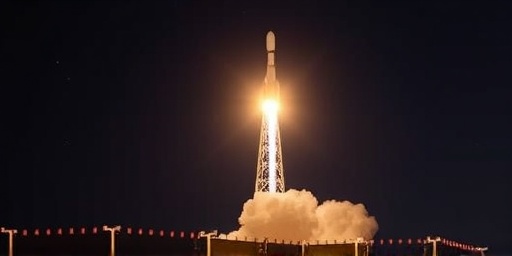In a groundbreaking announcement that could reshape the future of space exploration, Longshot Space has unveiled a working proof of concept for a massive 10-kilometer-long Space cannon capable of hurling several-ton payloads directly into low Earth orbit. This ambitious project from the up-and-coming aerospace firm promises to slash the costs and environmental impact of traditional rocket launches, potentially democratizing access to orbital technology for satellites and beyond.
The revelation came during a virtual press conference on October 15, 2024, where Longshot Space CEO Elena Vargas described the device as ‘the slingshot humanity has always dreamed of for the stars.’ Unlike conventional rockets that burn vast amounts of fuel to escape gravity, this electromagnetic railgun-style Space cannon uses a series of accelerators to propel objects at hypersonic speeds, achieving orbital velocity without the need for onboard propulsion. Early tests on a scaled-down model have successfully launched a 500-kilogram test payload to an altitude of 100 kilometers, simulating suborbital flight conditions.
Longshot Space, founded in 2020 by a team of former NASA engineers and private sector innovators, positions this innovation as a game-changer for the burgeoning satellite industry. With the global small satellite market projected to reach $13.7 billion by 2027 according to a recent report from MarketsandMarkets, the need for affordable and frequent satellite launch options has never been greater. Vargas emphasized that the full-scale cannon, stretching approximately 6 miles in length, could deploy payloads of up to 5 tons into orbit for a fraction of the current $10,000 per kilogram cost of rocket-based launches.
Proof of Concept Achieves Hypersonic Milestones
The heart of Longshot Space’s announcement is the successful demonstration of its prototype Space cannon, a 500-meter-long testbed constructed in a remote facility in the Nevada desert. During the reveal, engineers showcased footage of the device firing a dummy satellite at speeds exceeding Mach 5, reaching an apogee that mimicked the edge of space. ‘We’ve proven the physics works,’ said Dr. Marcus Hale, lead physicist at Longshot Space. ‘The electromagnetic coils generate a staggering 1.2 gigawatts of power over milliseconds, accelerating the payload without the inefficiencies of chemical rockets.’
This proof of concept builds on decades of research into electromagnetic launch systems, drawing inspiration from concepts like NASA’s old railgun projects and the U.S. Navy’s experimental railguns for naval artillery. However, Longshot’s design incorporates advanced superconducting materials and AI-optimized power distribution to handle the immense forces involved. In one test sequence highlighted in the press conference, the cannon achieved a muzzle velocity of 7.8 kilometers per second—precisely the speed needed for low Earth orbit insertion when combined with precise trajectory calculations.
Key statistics from the tests underscore the potential: energy efficiency is reported at 85%, compared to rockets’ 10-20% thrust-to-fuel ratio. The prototype’s modular design allows for scalability, with plans to extend the track length incrementally. Longshot Space has already secured patents for 12 core technologies, including a vibration-dampening system that prevents structural failure during launch. These milestones position the company as a frontrunner in orbital technology, challenging incumbents like SpaceX and Blue Origin who rely on reusable rockets.
Environmental benefits were also a focal point. Traditional satellite launch vehicles emit thousands of tons of CO2 per mission, contributing to the aerospace sector’s 2-3% share of global emissions. The space cannon, powered by renewable grid electricity, could reduce that footprint by up to 90%, according to internal modeling shared by the company. As climate concerns mount, this innovation aligns with international efforts like the UN’s Space2030 agenda to make space activities more sustainable.
Cutting Costs and Barriers in Satellite Deployment
At the core of Longshot Space’s vision is affordability, addressing one of the biggest hurdles in the satellite launch market. Current rideshare options from providers like Rocket Lab or SpaceX can cost operators between $5 million and $50 million per deployment, limiting participation to well-funded entities. The space cannon aims to drop that to under $1 million for a 1-ton payload, primarily by eliminating fuel and recovery logistics.
Imagine a constellation of CubeSats for Earth observation being launched daily, rather than in batches every few months. Longshot Space envisions the cannon as a ‘spaceport on rails,’ with multiple firing bays for simultaneous operations. In a white paper released alongside the announcement, the company detailed economic projections: a full-scale facility could handle 200 launches per year, generating $2 billion in annual revenue while creating 1,500 high-tech jobs in the host region.
Comparisons to existing orbital technology highlight the disruptive potential. SpaceX’s Falcon 9, while revolutionary for its reusability, still requires complex staging and landing maneuvers. The space cannon, by contrast, is ground-based and fire-and-forget, with payloads equipped only with minimal attitude control thrusters for final orbit adjustments. Early partners, including a European consortium of universities, have expressed interest in using the system for microgravity experiments, potentially accelerating research in materials science and biology.
Financial backing for this innovation is robust. Longshot Space raised $150 million in Series B funding last year from investors including Andreessen Horowitz and Boeing Ventures, earmarking $80 million for prototype scaling. CEO Vargas noted, ‘We’re not just building a gun; we’re forging a new era where space is accessible to startups, governments, and even educational institutions.’ This cost-cutting ethos could flood low Earth orbit with more satellites, enhancing global internet coverage via projects like Starlink analogs and improving disaster monitoring.
Engineering Challenges of Building the World’s Longest Accelerator
While the proof of concept dazzles, constructing a 10-kilometer space cannon presents formidable engineering obstacles that Longshot Space is candidly addressing. The structure must withstand extreme accelerations—up to 10,000 g-forces on payloads—while maintaining pinpoint accuracy to hit orbital insertion windows. Site selection is critical; the company is scouting equatorial locations like Ecuador or Kenya to leverage Earth’s rotational boost, minimizing energy needs.
One major hurdle is atmospheric drag. At launch speeds, air friction generates temperatures over 2,000 degrees Celsius, necessitating advanced aerospike sabots that encase payloads like a protective shell, ablating away during ascent. Longshot’s team has tested ceramic composites that survive these conditions, but scaling to full size will require wind tunnel validations at facilities like NASA’s Ames Research Center.
Power demands are another beast. The cannon’s electromagnetic rails will draw from a dedicated fusion-inspired microgrid, potentially incorporating small modular reactors for baseload energy. Regulatory approvals loom large, too—FAA and international space treaties will scrutinize airspace closures during firings, and debris mitigation protocols must comply with NASA’s orbital guidelines to prevent Kessler syndrome.
Despite these challenges, Longshot Space’s iterative approach inspires confidence. Phase 1 testing in 2025 will extend the prototype to 2 kilometers, with unmanned orbital attempts targeted for 2027. Collaborations with MIT’s Plasma Science and Fusion Center are yielding breakthroughs in coil efficiency, reducing operational costs by 40%. ‘Every challenge is an opportunity for innovation,’ Hale remarked, underscoring the company’s problem-solving ethos.
Industry Leaders and Experts React to the Orbital Game-Changer
The aerospace community has buzzed with reactions since Longshot Space’s reveal, blending excitement with skepticism. Elon Musk tweeted, ‘Ground-based launches? Bold move. Competition drives progress—welcome to the race.’ SpaceX, a dominant force in satellite launch, views the space cannon as complementary rather than competitive, with a spokesperson noting potential synergies for hybrid missions.
Experts like Dr. Laura Chen, a propulsion specialist at the International Space University, praised the concept’s elegance. ‘This could obsolete liquid-fueled rockets for routine LEO deployments, much like how container ships transformed ocean freight,’ she said in an interview. However, concerns persist: the European Space Agency’s director of launchers warned of vibration-induced payload stress, potentially unsuitable for delicate instruments like telescopes.
Investment analysts are bullish. A report from McKinsey & Company predicts that orbital technology innovations like Longshot’s could capture 15% of the launch market by 2035, spurring a $50 billion ecosystem. Smaller players, such as Planet Labs, have voiced enthusiasm for cheaper access, enabling denser satellite networks for climate tracking. Yet, geopolitical tensions arise—nations without coastal access may push for international space cannon hubs to avoid dependency.
Overall, the response underscores the innovation‘s polarizing nature: a visionary leap for some, a high-risk gamble for others. Longshot Space’s transparency in sharing test data has fostered trust, positioning it as a credible disruptor in an industry long dominated by government-backed behemoths.
Vision for a Multi-Purpose Space Cannon Era
Looking ahead, Longshot Space’s space cannon extends far beyond satellite launch, with applications poised to redefine orbital technology. In the near term, the system could support space tourism by lofting passenger capsules to suborbital heights, rivaling Virgin Galactic’s offerings at lower costs. Medium-term plans include resupply missions to the International Space Station, delivering cargo without the fuel overhead of Progress or Cygnus vehicles.
Longer horizons envision lunar and Martian gateways. By 2035, an upgraded cannon could propel interplanetary probes, leveraging vacuum tubes to extend acceleration into near-space. This innovation might enable megaconstellations for global 5G, bridging digital divides in underserved regions. Economically, it could stimulate a ‘space industrial park’ model, with on-site manufacturing of payloads using 3D-printed habitats.
Challenges notwithstanding, the project’s momentum is undeniable. With $200 million more in projected funding and partnerships with the UAE’s space agency, Longshot Space aims for operational status by 2029. As Vargas concluded, ‘This isn’t just about reaching orbit—it’s about making the stars our shared frontier.’ The implications ripple across industries, from telecommunications to defense, heralding an era where space is no longer the domain of the elite but a canvas for collective human ambition.







